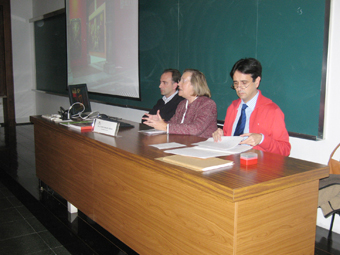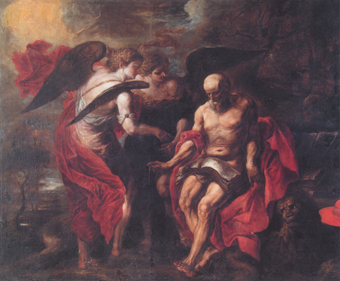23 November 2006
Vicente Berdusán in Aragón
Mr Juan Carlos Lozano López

From left to right: Mr. Juan Carlos Lozano (University of Zaragoza),
Ms. Concepción García Gainza and Mr. Ricardo Fernández Gracia (Chair of Navarrese Heritage and Art).
The knowledge of the painter Vicente Berdusán (Ejea de los Caballeros, Zaragoza, 1632-Tudela, Navarra, 1697) has experienced an extraordinary growth in the last thirty years, with outstanding historiographical milestones such as the article by Esteban Casado Alcalde in the magazine Príncipe de Viana (1998), the thesis by Isidro López Murías (1992) and the Catalog of the exhibition El pintor Vicente Berdusán. 1632-1697 (1998), curated by professors Mª Concepción García Gainza and Ricardo Fernández Gracia. In this exhibition, only 5 of the 25 works exhibited came from Aragon, a significant fact that demonstrated the existing imbalance between the knowledge of the Navarrese Berdusán -well studied, thanks among other reasons to the previous work carried out in the elaboration of the Catalog Monumental de Navarra- and the Aragonese Berdusán, in spite of the fact that since 1990 his birth in the town of Ejea de los Caballeros, Zaragoza, was already recorded. All this prompted us to dedicate the doctoral thesis to the painter's work in Aragon, convinced that his production could be, in quantity and quality, comparable to that developed in Navarra. And indeed, after six years of work which involved, among other things, the visit to more than three hundred localities and the enquiry of fifty archives, the issue of works of sure attribution has tripled (in total, about 150) and, in addition, the Berdusanesque corpus has been purified, eliminating everything that in the past had adulterated it. In this way, the critical and reasoned Catalog has been completed -the first of an Aragonese Baroque painter-, although it is susceptible to some new contribution that will undoubtedly come from private collectors or from the antiquarian trade. The work, in addition to the elaboration of this Catalog, has focused on the study of the clientele and the sources (graphic, literary and devotional) used by Berdusán.

Vicente Berdusán, Saint Jerome comforted by Angels, 1684. Daroca (Zaragoza)
Berdusán's work, all of which has religious themes, is spread throughout the three Aragonese provinces, from Hecho (Huesca) to Gea de Albarracín (Teruel), with a special - and logical - concentration in the area of the middle Ebro valley as a natural corridor historically used as a route of contacts and artistic influences, and in certain localities where the commissioning of a work of a certain size usually generates new commissions. This is the case of the city of Huesca (cathedral and convents of Capuchinas and Discalced Carmelites), Magallón (parish church, with the largest set of altarpieces - the largest and three collateral altarpieces - with works by the Axis-born artist), Daroca (collegiate church and church of San Miguel), Tarazona (cathedral and convent of the Discalced Carmelites) and the Cistercian monastery of Santa María de Veruela (with a group of twelve paintings, four of which form a cycle dedicated to the life of Saint Bernard. Outside these places, we find works by Berdusán (from large altar paintings to small easel works of devotional subject ) distributed in towns in Zaragoza such as Biota, Calatayud, Encinacorba, Fuendejalón, Los Fayos, Maluenda and Villafranca de Ebro, and in the Teruel towns of Albalate del Arzobispo and Ojos Negros, without counting others documented but not preserved or in unknown whereabouts, or those that for various reasons are outside Aragon (Figueras, Madrid, San Sebastián, etc.)...). In the lecture we have tried to show the most representative of this extensive production, as well as some images of the exhibition Vicente Berdusán (1632-1697). El artista artesano ( Zaragoza, Palacio de Sástago, 5 October-26 November 2006), which aims to disseminate the results of the research carried out since 1998.
